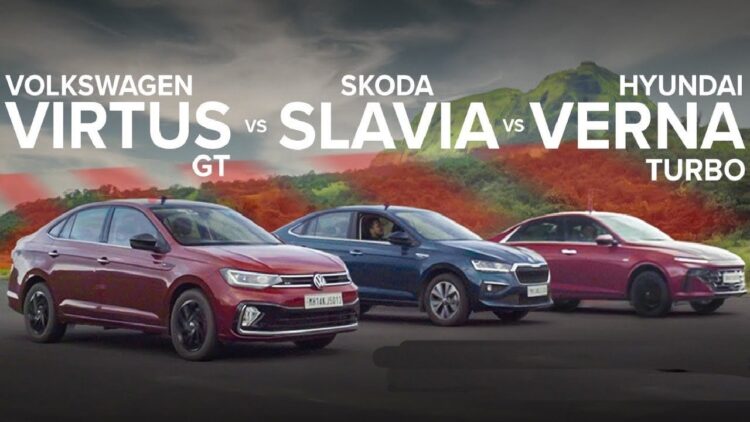This drag race between the VW Virtus, Skoda Slavia and Hyundai Verna will settle the debate once and for all. All these are premium mid-size sedans in India. They have their fanbase. However, Verna is the veteran in this segment, while the other two siblings are the new kids on the block. Before this new Verna with a new 1.5-litre turbo petrol mill, VW and Skoda cars were considered to be the sportiest in this segment. But this latest Verna brings a new character with it. Let us compare how well it performs against the trademark performance cars.
You may also like: Hyundai i20 N Line vs Maruti Fronx 1.0 Drag Race – Guess Who Wins!
VW Virtus vs Skoda Slavia vs Hyundai Verna Drag Race
This video comes from PowerDrift on YouTube. The team has a dedicated drag strip to compare the performances of the three cars thoroughly. This race consists of two parts. In the first phase, the Slavia goes up against the Virtus, while the second race takes place between the winner of this game and the Verna. For the first round, the drivers put their feet to the accelerators as both Slavia and Virtus get a decent launch. However, the Slavia stays slightly ahead from the beginning and ends up winning the round quite comfortably. To maintain the consistency of results and take into consideration the driving mannerisms and weights of each driver, the cars are swapped for the second round.
You may also like: Mahindra Scorpio N vs Toyota Fortuner Drag Race – Who Wins
Interestingly, the two cars remained neck-to-neck for a long duration this time around. Finally, the Slavia was able to take the pole position. This is quite surprising since both these vehicles share the powertrains, transmissions and even some body panels. After winning this race, it goes up against the Verna. Note that Verna is the most powerful car in the segment. In the first round of this race, the Verna was able to leave the Slavia behind from the start. Hence, it emerged victorious in the first round. Similar to the last race, they swapped drivers for the second attempt. This time around, the Slavia was able to beat the Verna. In conclusion, the hosts confirm that if all cars get a perfect launch, Verna is going to win every time.
You may also like: VW Virtus 1.0 Pwns Tata Nexon 1.2 in Drag Race – VIDEO
Specs Comparison
Skoda Slavia and VW Virtus share the engine and gearbox. For this race, there was a 1.5-litre turbo petrol engine powering both these cars generating 150 PS and 250 Nm of peak power and torque. This engine pairs with a 7-speed DCT automatic gearbox. On the other hand, the Verna has the 1.5-litre turbo petrol which makes 160 PS and 253 Nm of peak power and torque. It also has a 7-speed DCT gearbox. The high power and torque figures allow the Verna to beat the other two vehicles quite convincingly.
| Specs | Skoda Slavia | VW Virtus | Hyundai Verna |
| Engine | 1.5L Turbo Petrol | 1.5L Turbo Petrol | 1.5L Turbo Petrol |
| Power | 150 PS | 150 PS | 160 PS |
| Torque | 250 Nm | 250 Nm | 253 Nm |
| Transmission | 7-DCT | 7-DCT | 7-DCT |
You may also like: Tata Nexon EV vs Modified Skoda Kushaq Drag Race – VIDEO
Author’s Note
We recognize that YouTubers often use drag races to assess vehicle performance. However, it’s important to recognize that these races can have lasting effects on cars, as everyday driving typically doesn’t involve high-acceleration straight-line bursts. Participating in drag races with personal vehicles is not recommended due to safety and mechanical concerns. We strongly discourage our readers from attempting such activities and emphasize that drag races do not faithfully replicate real-world driving conditions.
You may also like: New Hyundai Verna (Non-Turbo) vs Tata Nexon EV Drag Race- VIDEO
Disclaimer- The embedded videos/ external content is/are being used as a convenience and for informational purposes only; they do not constitute an endorsement or approval by Car Blog India of any of the products, services, and /or opinions of the corporation or organization or individual. Car Blog India bears no responsibility for the accuracy, legality, and/or content of the external site or for that of subsequent external videos/ external content. Contact the external publisher for answers to questions regarding its content.


